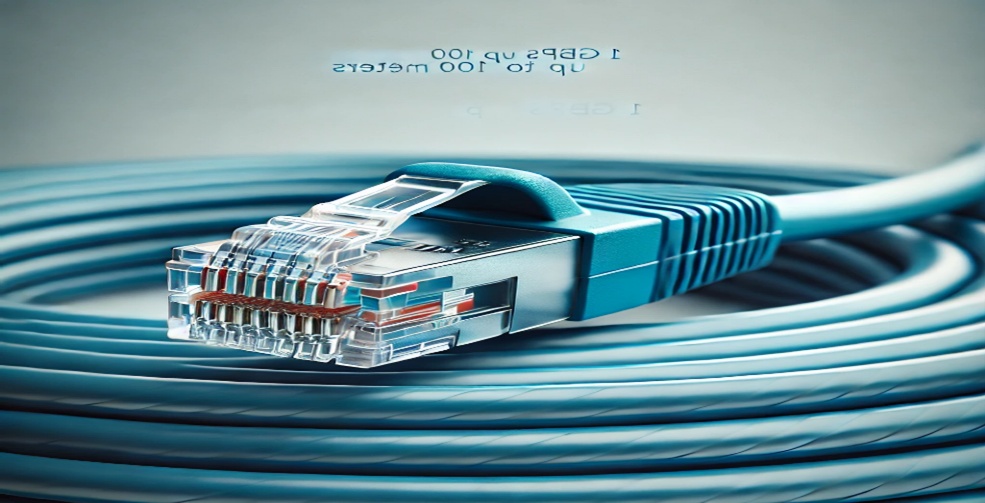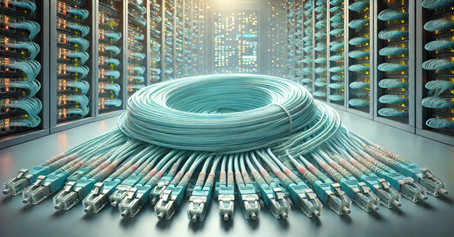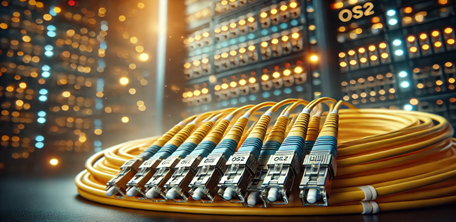The Complete Guide to Structured Cabling Solutions for Modern Businesses
In today's digital-first business environment, your network infrastructure forms the backbone of virtually every operation. A well-designed structured cabling system is no longer a luxury—it's a critical foundation that determines how efficiently your organization can communicate, collaborate, and compete, especially when implementing cloud solutions for business.
What is Structured Cabling and Why Does it Matter?
Structured cabling is a comprehensive approach to building a telecommunications infrastructure that includes all the necessary hardware and cabling components organized according to established standards. Unlike point-to-point cabling, structured cabling follows a methodical architecture that supports current needs while accommodating future growth and successful cloud implementation.
The benefits of implementing a proper structured cabling system include:
- Simplified troubleshooting and maintenance
- Reduced downtime during network changes
- Increased flexibility for additions, moves, and changes
- Support for higher bandwidth applications and cloud computing implementation
- Enhanced reliability and performance
- Lower long-term operational costs
Key Components of a Structured Cabling System
A structured cabling system is an organized approach to network cabling that supports voice, data, video, and other communication services. It consists of six interrelated subsystems, each designed to optimize network performance, scalability, and reliability for effective business solutions in the cloud.
1. Entrance Facilities (EF)
The Entrance Facility (EF) is the primary point where external service provider connections enter the building and integrate with the internal network. Proper planning ensures network reliability, security, and compliance with industry standards such as TIA/EIA-568, ANSI/TIA-606, and BICSI guidelines.
Key Components of Entrance Facilities:
- Demarcation Point (Demarc): The interface between the external service provider's network and the internal structured cabling system.
- Carrier Connection Equipment: Fiber optic or copper interfaces for connecting to Internet Service Providers (ISP), telephone lines, or private network circuits.
- Grounding & Bonding Infrastructure: Protects equipment from electrical surges, lightning strikes, and static discharge.
- Conduits, Sleeves & Entrance Pathways: Ensures organized cable routing while preventing physical damage.
- Environmental Controls: Secure and climate-controlled enclosures to prevent moisture, extreme temperatures, or electromagnetic interference (EMI).
2. Equipment Rooms (ER)
Equipment rooms house mission-critical network hardware and backbone connections. These rooms are strategically placed within a building or campus to facilitate efficient network distribution and cloud implementation steps.
Key Components of Equipment Rooms:
- Main Distribution Frame (MDF): The central hub where backbone cabling, service provider connections, and core networking equipment converge.
- Core Network Devices:
- Routers & Firewalls: Manage data traffic and security policies.
- Switches: Facilitate local network connections and traffic switching.
- Servers: Handle applications, storage, cloud services, and centralized computing.
- Cooling & Ventilation Systems:
- HVAC & Precision Cooling Systems to prevent overheating.
- Hot/Cold Aisle Containment for efficient airflow.
- Power Backup & Redundancy:
- Uninterruptible Power Supply (UPS) & Backup Generators ensure 24/7 uptime.
- Power Distribution Units (PDU) to regulate power flow to critical equipment.
- Physical Security Measures:
- Access Control (Keycard/Biometric Authentication) to prevent unauthorized access.
- Video Surveillance & Fire Suppression Systems for enhanced protection.
3. Telecommunications Rooms (TR)
Telecommunications rooms serve as distribution points for structured cabling within a building, connecting backbone cabling to horizontal cabling to support implementing cloud solutions.
Key Components of Telecommunications Rooms:
- Intermediate Distribution Frames (IDFs): These act as secondary distribution hubs, linking end-user connections to the MDF.
- Patch Panels:
- Fiber & Copper Patch Panels facilitate easy management of network connections.
- Color-Coded Labels & Documentation simplify troubleshooting.
- Network Switches & Cable Management:
- Rack-mounted switches for efficient network distribution.
- Horizontal & Vertical Cable Managers to maintain organized and tangle-free cabling.
- Power & Cooling:
- Dedicated Cooling Fans or Small HVAC Systems for heat management.
- Rack-Mounted PDUs to ensure stable power distribution.
4. Backbone Cabling (Riser Cabling)
Backbone cabling is the high-capacity infrastructure that connects entrance facilities, equipment rooms, and telecommunications rooms across a building or campus, critical for businesses implementing cloud solutions.
Key Characteristics of Backbone Cabling:
- Media Type:
- Fiber Optic Cabling (Single-Mode & Multi-Mode): Preferred for long-distance, high-speed communication (1Gbps to 100Gbps).
- Shielded Twisted Pair (STP) & Unshielded Twisted Pair (UTP): Used for shorter-distance, high-speed data connections.
- Pathways & Installation Considerations:
- Vertical Backbone (Riser Cabling): Runs between floors.
- Horizontal Backbone: Connects different rooms and sections within a floor.
- Termination & Connector Types:
- SC, LC, MTP/MPO Connectors (for fiber optic cables).
- RJ45 (for copper-based backbones).
- Compliance & Safety Standards:
- Fire-Rated Cabling & Plenum-Rated Conduits to comply with safety regulations.
5. Horizontal Cabling
Horizontal cabling connects telecommunications rooms (TRs) to individual workstations, conference rooms, and other end-user locations. This is often referred to as the last-mile connection in structured cabling for comprehensive IT solutions for businesses.
**Key Components of Horizontal Cabling: **
- Cable Types:
- Category 6, 6A, 7, and 8 Copper Cables: Support high-speed Ethernet (1Gbps – 40Gbps).
- Fiber Optic Cabling: Increasingly used in modern office environments for higher bandwidth.
- Termination Points:
- RJ45 Outlets (Network Jacks) & Patch Panels for modular connections.
- Cable Routing Methods:
- Cable Trays, Conduits & Raised Flooring for organized installations.
- Plenum vs. Non-Plenum Spaces: Ensuring compliance with building codes & fire safety standards.
- Maximum Length Considerations:
- Copper (UTP/STP) Limit: 90m (295ft).
- Fiber Optic: Up to several kilometers depending on type.
6. Work Areas (WA)
The work area includes the final network connection points where users access data, voice, and video services. This is where structured cabling meets end-user devices and cloud solutions for businesses.
Key Components of Work Areas:
- Network Outlets & Faceplates:
- Standardized RJ45 Ports for easy plug-and-play connectivity.
- Modular Wall Plates to support data, voice, and power connections.
- Patch Cords & Cable Management:
- Ethernet Patch Cords (Cat 6A, Cat 7, Cat 8) for connecting devices.
- Velcro Straps & Cable Organizers to prevent cable clutter.
- User Devices & Peripherals:
- Computers, VoIP Phones, Printers, Wireless Access Points (WAPs).
- Smart IoT Devices such as surveillance cameras and automation systems.
- Compliance & Accessibility Standards:
- ADA (Americans with Disabilities Act) Compliance for workstation accessibility.
- Ergonomic Desk Layouts to prevent cable strain and tangling.
Industry Standards and Best Practices
Adhering to established telecommunications and networking standards ensures efficiency, reliability, interoperability, and scalability for businesses implementing cloud solutions. Below are key standards and their significance:
1. ANSI/TIA-568 Series (Structured Cabling Systems)
- Defines structured cabling for commercial buildings.
- Covers cable categories (Cat5e, Cat6, Cat6A, fiber optics, etc.), distances, connectors, and performance criteria.
- Ensures interoperability between vendors and future-proofing of networks.
2. ANSI/TIA-569 (Pathways and Spaces)
- Defines the design and layout of pathways (conduits, cable trays, raceways) for structured cabling.
- Addresses telecommunications room design, space allocation, and environmental factors (cooling, accessibility).
3. ANSI/TIA-606 (Cabling Administration and Labeling)
- Establishes systematic documentation and labeling for network infrastructure.
- Aids in cable identification, troubleshooting, and maintenance for IT professionals.
4. ANSI/TIA-607 (Grounding and Bonding)
- Specifies grounding and bonding requirements to mitigate electrical hazards, EMI (Electromagnetic Interference), and ensure equipment safety.
- Critical for data centers, telecom rooms, and network reliability.
Additional Best Practices
- BICSI Standards – Guidelines for structured cabling design, installation, and maintenance.
- ISO/IEC 11801 – International standard for structured cabling (aligns with ANSI/TIA-568).
- NEC (National Electrical Code) – Addresses electrical safety, especially concerning cabling installation.
- IEEE 802 Standards – Governs networking protocols (Ethernet, Wi-Fi, etc.).
Benefits of Compliance
✔ Interoperability – Ensures compatibility between different vendors' equipment. ✔ Scalability – Allows for network expansion and future upgrades. ✔ Performance & Reliability – Optimized speed, minimal signal loss, and reduced downtime. ✔ Regulatory Compliance – Meets industry safety and operational requirements.
Following these standards ensures your cabling infrastructure will support current and future applications while maintaining compatibility with industry-standard equipment, essential for cloud solutions for businesses.
Choosing the Right Cabling for Your Needs
Selecting appropriate cabling types depends on your specific requirements and cloud implementation needs:
Copper Cabling Options
1. Category 6 (Cat 6) – Standard for Gigabit Networks
 Category 6 (Cat 6) Ethernet cable with RJ45 connector - the standard for Gigabit networks
Category 6 (Cat 6) Ethernet cable with RJ45 connector - the standard for Gigabit networks
- Maximum Data Rate: Supports 1 Gbps (Gigabit Ethernet) at a full distance of 100 meters (328 feet).
- Frequency Bandwidth: 250 MHz, which allows for reduced signal loss and better performance compared to Category 5e.
- Structure & Shielding:
- Available in unshielded twisted pair (UTP) and shielded twisted pair (STP) versions.
- Shielded versions (STP) offer better protection against electromagnetic interference (EMI).
- Backward Compatibility: Works with Cat 5 and Cat 5e networks.
- Use Case:
- Commonly used in residential networking, small offices, and general commercial applications.
- Suitable for applications like video streaming, VoIP calls, and cloud computing where Gigabit speeds are adequate.
- Advantages:
- Cost-effective for Gigabit Ethernet networks.
- Improved crosstalk performance over Cat 5e due to tighter twisting of wire pairs.
2. Category 6A (Cat 6A) – Enhanced for 10-Gigabit Speeds
 Category 6A (Cat 6A) Ethernet cable and switch - supports 10 Gigabit speeds up to 100 meters
Category 6A (Cat 6A) Ethernet cable and switch - supports 10 Gigabit speeds up to 100 meters
- Maximum Data Rate: 10 Gbps (10-Gigabit Ethernet) over 100 meters (328 feet).
- Frequency Bandwidth: 500 MHz, double that of Cat 6.
- Structure & Shielding:
- Available in both UTP and STP, but shielded Cat 6A is recommended to reduce crosstalk and interference.
- Improved alien crosstalk resistance (reduces interference from adjacent cables).
- Backward Compatibility: Fully backward compatible with Cat 6 and Cat 5e networks.
- Use Case:
- Suitable for enterprise networks, hospitals, industrial applications, and high-performance workstations.
- Frequently used in data centers and high-speed environments requiring 10-Gigabit Ethernet.
- Ideal for PoE (Power over Ethernet) applications like security cameras and wireless access points.
- Advantages:
- Supports higher speeds over longer distances than Cat 6.
- Future-proof investment for growing network demands and cloud implementation.
3. Category 8 (Cat 8) – Designed for Ultra-High-Speed Networks
 Category 8 (Cat 8) cabling in data center environment - designed for ultra-high-speed networks up to 40 Gbps
Category 8 (Cat 8) cabling in data center environment - designed for ultra-high-speed networks up to 40 Gbps
- Maximum Data Rate:
- 25 Gbps (25-Gigabit Ethernet) or 40 Gbps (40-Gigabit Ethernet).
- Maximum Distance:
- Supports 30 meters (98 feet) of full-speed performance.
- Beyond 30 meters, performance may degrade significantly.
- Frequency Bandwidth: 2000 MHz (2 GHz), significantly higher than Cat 6 and Cat 6A.
- Structure & Shielding:
- Fully shielded (S/FTP – Shielded Foiled Twisted Pair) to prevent external interference.
- Consists of individual shielded pairs and an overall shield, ensuring minimal signal loss and interference.
- Backward Compatibility: Works with Cat 7, Cat 6A, and lower categories, but performance will be limited to the lowest category's speed.
- Use Case:
- Primarily used in high-speed data centers and hyperscale computing environments.
- Essential for server-to-server connections, high-performance computing, and backbone infrastructure.
- Limited use in residential or office settings due to short-range support and higher cost.
- Advantages:
- Best-in-class shielding ensures maximum protection from EMI and crosstalk.
- Enables ultra-fast data transmission for specialized network environments.
- Future-proof for next-generation data center applications and cloud solutions for businesses.
Fiber Optic Options
When selecting fiber optic cabling for implementing cloud solutions, it's essential to consider factors such as bandwidth requirements, transmission distance, environmental conditions, and budget:
1. OM3/OM4 Multimode Fiber
 OM3/OM4 Multimode Fiber optic cables - optimized for high-speed data transmission in data centers and enterprise networks
OM3/OM4 Multimode Fiber optic cables - optimized for high-speed data transmission in data centers and enterprise networks
- Best for: High-speed data transmission over shorter distances
- Speed & Distance: Supports 10 Gbps up to 400 meters, 40 Gbps up to 150 meters, and 100 Gbps up to 100 meters
- Usage: Commonly used in data centers, enterprise networks, and high-speed LANs
- Advantages:
- Cost-effective for short-range applications
- Uses lower-power transceivers compared to single-mode fiber
- Excellent for high-density, high-speed network environments and cloud computing implementation
2. OS2 Single-Mode Fiber
 OS2 Single-Mode Fiber optic cables - designed for long-distance, high-bandwidth communication across large networks
OS2 Single-Mode Fiber optic cables - designed for long-distance, high-bandwidth communication across large networks
- Best for: Long-distance, high-bandwidth communication
- Speed & Distance: Capable of 40/100 Gbps transmission over distances exceeding 10 km (6.2 miles) and up to 100 km (62 miles) with amplification
- Usage: Ideal for telecommunications, long-haul networking, and large-scale data centers
- Advantages:
- Minimal signal loss over long distances
- Supports future network scalability with emerging ultra-high-speed technologies
- More efficient for backbone and metro network infrastructure when implementing cloud solutions
Planning for Future Technology Needs
A well-structured cabling system should not only meet current demands but also accommodate future advancements in technology for comprehensive IT solutions for businesses. Implementing a forward-thinking approach ensures efficiency, cost-effectiveness, and seamless integration of new technologies as they emerge.
1. Bandwidth Growth
As data consumption and application demands increase, planning for higher bandwidth is essential when implementing cloud solutions.
- Capacity Expansion: Plan for at least 5-10 times current capacity to accommodate future data usage growth.
- Cable Selection: Deploy higher-category cables such as Cat6A, Cat7, or fiber optics to support higher speeds and reduced latency.
- Multi-Gigabit Ethernet: Consider 2.5G, 5G, 10G, or beyond to ensure network scalability and long-term performance.
- Upgrading Backbone Infrastructure: Use fiber-optic cabling for backbone connections to future-proof against increasing data rates.
2. Emerging Technologies
The growing adoption of smart technology and new communication standards requires a robust infrastructure for effective cloud implementation steps.
- IoT Integration: As the Internet of Things (IoT) expands, more connected devices such as sensors, smart building systems, and automation tools will require stable and scalable cabling solutions.
- Wi-Fi 6/6E and 7: The latest wireless standards support increased device density and higher throughput, demanding fiber-ready backbones and enhanced cabling.
- 5G and Edge Computing: Low-latency applications require closer data processing capabilities. Implementing structured cabling that supports 5G small cells and edge computing ensures better performance.
- Cloud Computing Readiness: Increasing cloud adoption necessitates high-speed data transfers and a resilient cabling infrastructure to support continuous access.
3. Power over Ethernet (PoE) Readiness
PoE technology is crucial for powering a growing number of networked devices efficiently when implementing cloud solutions.
- Higher PoE Standards: Use Cat6A or higher to support IEEE 802.3bt (up to 100W), enabling the seamless operation of high-power devices like security cameras, VoIP phones, and wireless access points.
- Heat Dissipation Management: Implement proper cable bundling and spacing techniques to prevent overheating and performance degradation.
- Enhanced Cabling Infrastructure: Ensure cabling supports high-power PoE applications while maintaining efficiency and network stability.
4. Redundancy & Reliability
A resilient network design prevents downtime and enhances operational continuity for business solutions in the cloud.
- Diverse Pathways: Create multiple cable routes to eliminate single points of failure and ensure uninterrupted connectivity.
- Dual-Core Fiber: Deploying dual-core fiber enhances network availability and reliability.
- Backup Power Solutions: Integrate uninterruptible power supplies (UPS) and generator systems to maintain network operations during power disruptions.
- Disaster Recovery Planning: Establish a robust contingency plan for quick recovery in case of network failures.
5. Scalability & Modular Design
A structured and modular approach ensures adaptability to future technological changes for businesses implementing cloud solutions.
- Flexible Patching Panels: Allow for easy modifications and expansions without major overhauls.
- Data Center-Style Cabling Trays: Facilitate organized cabling and simplified maintenance.
- Pathway Expansion: Ensure conduits and cable pathways have at least 30-50% spare capacity for future growth.
- Structured Cabling Framework: Adopt industry-standard cabling frameworks that allow seamless integration of new technologies.
Best Practices for Future-Proofing
To ensure your cabling infrastructure remains relevant and adaptable for cloud implementation, consider the following: ✔ Deploy Fiber-Optic Cabling: Use fiber for backbone connectivity to handle future high-speed network demands. ✔ Plan for Increased Wireless Density: Ensure adequate cabling for future wireless access points (APs) to support expanding Wi-Fi needs. ✔ Structured Labeling and Documentation: Maintain clear labeling and comprehensive documentation to simplify troubleshooting and future upgrades. ✔ Implement Software-Defined Networking (SDN): Use SDN to enable flexible, scalable, and efficient network management. ✔ Regular Infrastructure Assessments: Conduct periodic network audits and upgrades to stay ahead of technological advancements.
- Bandwidth growth: Plan for 5-10x current requirements
- Emerging technologies: Consider IoT devices, Wi-Fi 6/6E, and 5G integration
- Power over Ethernet (PoE): Ensure cabling can support higher power devices
- Redundancy requirements: Implement diverse pathways for critical systems
- Scalability: Design with expansion capabilities built-in
Implementation Process: From Assessment to Certification
A successful structured cabling project follows these key phases for implementing a cloud solution:
- Site assessment and requirements gathering
- System design and documentation
- Material selection and procurement
- Installation according to standards
- Testing and certification
- Documentation and warranty
Working with certified professionals ensures your implementation meets industry standards and manufacturer specifications for comprehensive IT solutions for businesses.
Maintenance and Management Best Practices
Protecting your investment in cloud implementation requires ongoing attention:
- Regular visual inspections
- Periodic testing and certification
- Proper documentation of changes
- Adherence to cable management protocols
- Environmental monitoring
- Staff training on proper handling
Conclusion: The Business Value of Professional Structured Cabling
Investing in a properly designed and implemented structured cabling system delivers significant business value for cloud solutions for businesses:
- Reduced operational costs through simplified management and maintenance
- Enhanced productivity with reliable, high-performance connectivity
- Future-proofed infrastructure that accommodates technological evolution
- Improved resilience with reduced downtime and faster problem resolution
- Better ROI on technology investments by extending useful life
By partnering with experienced structured cabling professionals, your organization can build a solid foundation for current operations while preparing for future growth and technological advancement when implementing cloud solutions.
Contact our team today for a comprehensive assessment of your structured cabling needs and discover how our solutions can transform your network infrastructure for effective cloud computing implementation.


